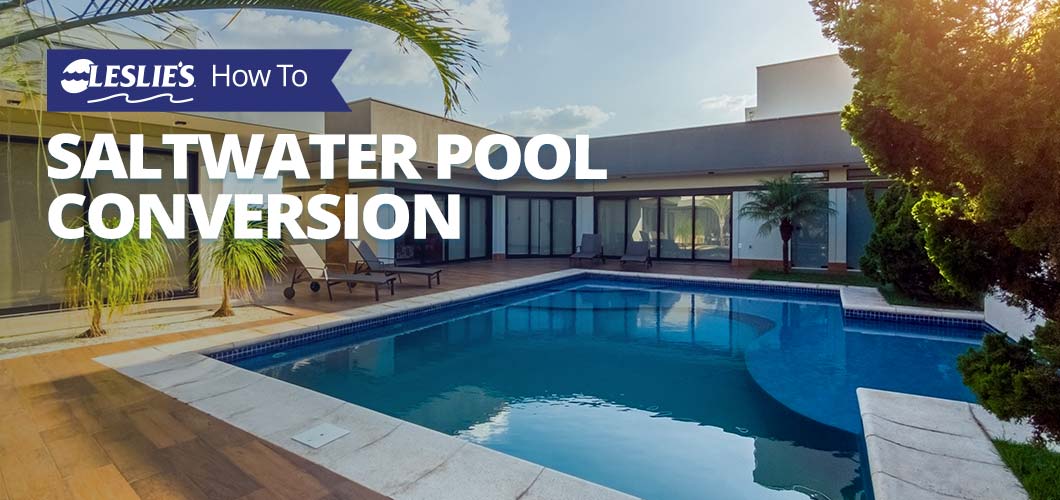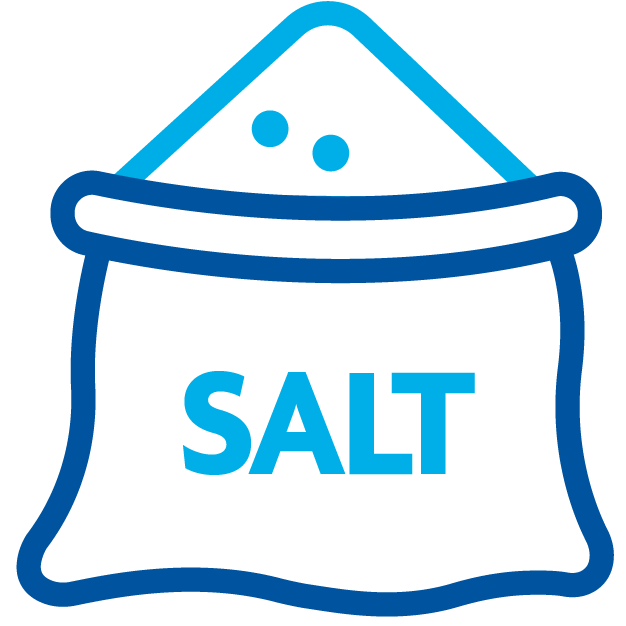
Saltwater Pool Conversion: A DIY Guide
Saltwater swimming pools have gained popularity in recent years, and for many reasons. They're generally low maintenance and offer a consistent and reliable supply of chlorine without having to handle or store traditional chlorine products. Plus, the water can be more comfortable for swimming. Converting your traditional chlorine pool to a saltwater chlorination system may seem complicated at first. But with this simple step-by-step guide, we'll help you learn how to complete a saltwater pool conversion on your own. We'll also go over common questions related to saltwater pool conversion costs, as well as the pros and cons tied to salt pools.
How Much Does a Saltwater Pool Conversion Cost?

When converting your pool to salt water, the biggest expenses involve purchasing a salt system for your pool and, of course, the salt itself. Depending on the size of your pool and the quality of equipment you purchase, the total cost for most salt conversions ranges from $1,500–$2,500.
The Saltwater Chlorine Generator
Complete salt systems for inground swimming pools usually start around $800, and can cost upwards of $2,000 depending on pool size and chlorine output. The average cost to buy equipment for a new salt system is about $1,300–$1,500.
The Pool Salt
Once you've purchased the saltwater chlorine generator, it's time to buy the salt that powers it. To figure out the amount of pool salt needed to convert your pool, you'll have to do a bit of math. First, find your pool volume in gallons. Second, figure out the ppm (parts per million) salt concentration needed for your system, according to manufacturer recommendations. Some brands recommend salinity level as low as 2,500 ppm, while others suggest upwards of 5,000 ppm. Finally, use the following equation to calculate the amount of salt you'll need to add to the pool:
8.375 x Salinity Increase ÷ 100 = Pounds of salt per 10,000 gallons
For example, we'll assume we have a 15,000-gallon pool, and our goal is to reach a salt level of 3,200 ppm, but we're starting with a salt reading of 0 ppm:
8.375 x 3200 ppm ÷ 100 = 268 lbs of salt per 10,000 gallons
Conversion: 268 lbs x (15,000 gal ÷ 10,000 gal) = 402 lbs for 15,000 gallons
Large 40-pound bags of pure pool-grade salt usually cost an average of about $12 each at your local pool store. Assuming we'd need at least 10 bags for our example pool (400 lbs), we're looking at a salt cost of approximately $120.
BONUS TIP: There are a lot of questions related to salt cells and salt system maintenance. We answer many of them in our other post, Salt Cell FAQ. Before you begin a saltwater pool conversion, take a minute to review the ins and outs of saltwater sanitizers.
Should I Convert My Pool to a Salt System?

Saltwater pools vs. traditional chlorine pools — should you make the switch? The answer to this question comes down to personal preference. What's right for another pool owner might not be right for you. It's important to consider all the pros and cons carefully before making your decision. Once you complete your saltwater pool conversion, you're essentially stuck with a salt system, unless you choose to drain the pool and start fresh. There are two sides to the pool salt argument:
Pros:
Easy water treatment. Owners of saltwater pools enjoy the low maintenance approach to sanitization. You'll no longer have to worry about refilling a chlorine tablet feeder or carrying heavy buckets of chlorine. The chlorine generator cell produces a steady stream of chlorine to keep your pool properly sanitized.
Swimmer comfort. Most people who swim in saltwater pools report a pleasant experience in soft, smooth-feeling water. They don't experience eye and skin irritation from chloramines, and their hair doesn't feel dry after swimming.
No chlorine smell. Strong chloramine odors are a thing of the past with a saltwater pool system.
No salty taste. Contrary to popular belief, you shouldn't be able to taste the salt in a saltwater pool. For context on salt content, the ocean measures around 35,000 ppm, and human tears are around 7,000 ppm. Salt is only detectable to your sense of taste starting at around 5,000 ppm, and most saltwater pool systems are in the range of 2,500–3,500 ppm, depending on manufacturer recommendations.
Cons:
Cost. Although annual expenses to maintain a saltwater pool tend to be lower than traditional chlorine pools, those savings quickly disappear when you take the cost of equipment into account. Of course, there are the start-up expenses to convert your pool in the first place. But you also have to consider the life of the salt cell, which should be replaced every 3–5 years. If the control board fails, you'll be looking at a costly repair or complete replacement.
Chemical needs. On the one hand, you're not lugging around heavy buckets of chlorine tablets. However, to protect the chlorine generated by your salt cell, you'll need to make sure there's adequate Cyanuric Acid (CYA) in the pool, at least 30–50 ppm. You can increase CYA levels with pool conditioner or stabilizer. You may also spend a bit more on stain and scale prevention chemicals due to the corrosive nature of salt, which we'll talk about next.
Long-term maintenance. The nature of salt water presents its own challenges. For one, it facilitates the accelerated corrosion of metal parts in your pool. Whether it's metal accessories around the pool (ladders, diving board hardware, wall screws, rebar, etc.) or the equipment that runs it, you can count on galvanic corrosion costing you extra sooner or later. It can also wear down plaster surfaces faster than normal, shortening the amount of time between resurfacing projects.
Not compatible with biguanide. If you currently use biguanide as your primary sanitizer, you'll have to drain your pool before you can convert to a salt chlorine system.
Warranty coverage. Certain swimming pools and models of pool equipment are not compatible with saltwater systems. Converting your pool to a salt system may void the warranty from the manufacturer or your pool builder. Be sure to read the fine print carefully before you proceed with a saltwater pool conversion.
Required Materials for a Saltwater Pool Conversion

Before we go into the steps involved in converting your pool to a salt system, it's important to gather all the needed supplies. Make sure all PVC pieces and the salt cell are the correct size for your pool and plumbing setup.
For this project, you will need:
- PVC couplers and/or adapters
- 2’ section of PVC
- PVC snips or a hacksaw
- PVC glue
- High purity pool salt
- Saltwater chlorine generator (controller and cell)
- Personal Protective Equipment (PPE), such as safety glasses and gloves
1. Test Your Pool Water

First things first — test your pool water. Test all aspects of water chemistry to make sure your pool is well balanced. This will prevent any chemical-related mishaps during the transition. Your water should be within the following ideal ranges:
- Total Alkalinity: 80–120 ppm
- pH: 7.4–7.6
- Calcium Hardness: 200–400 ppm
- Cyanuric Acid: 30–50 ppm
- Free Available Chlorine: 2.0–4.0 ppm
- Metals: 0 ppm
- Total Dissolved Solids: 0–2,500 ppm
Adding salt will only drive your Total Dissolved Solids (TDS) reading higher. So if your current TDS level is already above 2,500 ppm, you may need to take an extra step. We recommend partially draining and refilling the pool to bring the TDS levels down before converting your pool to salt. This will save you from water clarity issues and other water balance problems later.
BONUS TIP: Starting with a perfectly balanced pool will ensure the success of your saltwater pool conversion. Bring a water sample to your local Leslie's for our always free in-store AccuBlue water test. You'll receive a precise 10-point water analysis and a customized water treatment plan in 60 seconds. Then, our certified pool experts will walk you through each step on your way to a clean, safe, and beautiful pool.
2. Add Salt to the Pool

If you already completed the equation above, you'll know exactly how much salt you need to add to the pool. Add one bag of salt to the pool at a time, walking around the perimeter of the pool while the circulation system is running. Brush the pool to help speed up the dissolving process.
It's always easier to add more salt later than it is to overdose the pool. If your calculations were incorrect, and you add too much salt to the pool, you may have to partially drain and refill the pool to bring the levels back down into the recommended range. Don't be afraid to test the water for salt content throughout this process, especially as you approach your last bag(s). Better safe than sorry!
3. Install Your Saltwater Chlorine Generator
The salt system you purchase for your swimming pool should be properly sized for your pool volume. A salt cell that's undersized will have to work overtime to keep up with the demands of your pool, and it will often fail faster. When it comes to salt systems for pools, bigger is always better.
First, flip the breaker to your pool's equipment pad. There should be no power coming to your pool equipment during installation. Next, mount the power center or control box on a wall or post near the equipment pad. There may be some electrical work involved, unless you purchased a system that includes a plug. Finally, install the cell inline with the pool plumbing. It should be the last piece of equipment the water passes through before returning to the pool. This is the step where you'll need many of the supplies we mentioned earlier in this post.

4. Turn on the Pump
Connect the system controller to the chlorine generator cell, and turn the power back on at your breaker box. Turn on the pump after it has primed, and look carefully for any signs of a leak. Continue running the pump to finish dissolving the salt, but don't turn on your salt system quite yet.
5. Re-Test the Water and Turn on the Salt System
Use an at-home salt test to confirm that salt levels are within the manufacturer's recommended ideal range. If they are, you're ready to turn on your salt cell!
Maintenance Tips After a Saltwater Pool Conversion
As we mentioned earlier in the pros and cons section, saline water has its own set of maintenance challenges. These tips will help you care for your saltwater pool:
- Saltwater pools tend to have a naturally higher pH, so keep a supply of Leslie's Dry Acid or muriatic acid on hand.
- Use Leslie's Stain & Scale Prevent as part of your regular maintenance plan. This will help protect your salt cell from the harmful effects of calcium in the water.
- Clean the salt cell every 3 weeks during swimming season to prolong the life of your cell.
- Use a “dummy cell” in the cooler off-season months to protect your cell. It can't work efficiently in cool temperatures, so this extra step will keep it from overworking. A dummy cell will also protect against accidental winter freeze damage.
- Hose down the pool deck often to reduce the effect of salt corrosion on metal items, wood, and unsealed stone around the pool area.
Got questions? We have the answers! If you're thinking of converting your pool to a saltwater system, the experts at Leslie's are here for you. Call or stop by your local Leslie's today! Whether you need a professional water test, or you're looking for service support to install or clean your salt cell for you, our team of certified service technicians can help.